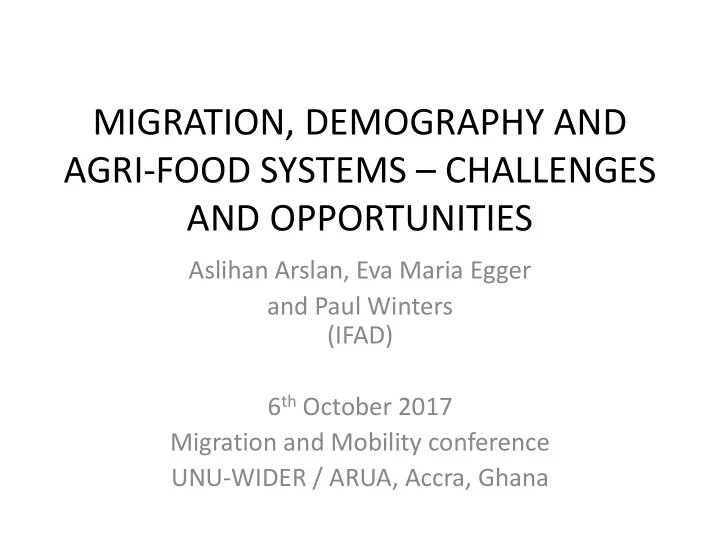

MIGRATION, DEMOGRAPHY AND AGRI-FOOD SYSTEMS – CHALLENGES AND OPPORTUNITIES Aslihan Arslan, Eva Maria Egger and Paul Winters (IFAD) 6 th October 2017 Migration and Mobility conference UNU-WIDER / ARUA, Accra, Ghana
Introduction • Rural transformation process shaped by evolving agri-food systems (AFS): – Large share of employment (incl. non-farm) – Increasing connection of rural and urban sectors – Success stories in some regions, others to be seen • Demographic structures – Rural population still growing in some regions – “Youth bulge” expected in Africa What is the role of rural-to-urban (youth) migration?
Agri-food systems • Include farming, food and fibre manufacturing and trade • Embedded in changing economic system (globalisation, technological change, urbanisation, dietary change) • Provide about 80% of the jobs in developing countries, where farming is still the dominant employer • Connect rural and urban sector
This paper: • Outline the interaction of changing demographics and rural-urban migration with AFS • Utilize population data to project future migration patterns and how they relate to changing AFS • Discuss role of climate change • Identify research and data gaps • Suggest areas for investment needs • Focus on developing countries
Outline 1. Conceptual framework 2. Data and methodology 3. Descriptive analysis: 1. Trends in demographic structures 2. Trends in rural-urban migration 3. Trends in AFS 4. Role of climate change 5. Conclusion
Traditional pathways RURAL URBAN Pull factors Push Factors Increased Ind. Prod. Surplus Labor Demand for labor (Dual-sector model, Lewis) Higher wages Low wages (Harris-Todaro) Income diversification Land constraints Credit/Insurance constraints (NELM)
Emerging trends
Data • Rural and urban population by age 1980-2015 (URPAS, UN) • Total and rural population 2015-2050 (WUP, UN) • Total population by age 2015-2050 (WPP, UN) • Life expectancy at birth, total (in years) (World Development Indicators (WDI), World Bank) • Agricultural productivity (value added per worker, RDR IFAD 2016)
Country groupings • By region: o East and Central Africa (ECA) (N=25) o West and Southern Africa (WSA) (N=26) o Northern Africa, Middle East and Central Asia (MENACA) (N=30) o Asia and the Pacific (APR) (N=28) o Latin America and the Caribbean (N=48) o North America and Europe (NAEU) (N=54) o Oceania, Australia, New Zealand (OC) (N=21)
Rural transformation pathways and demographic structures
Rural transformation pathways and demographic structures
Methodology to project rural-urban migration rates: Survival ratio method • 𝑇𝑆 𝑢+5 = 𝑄𝑝𝑞 𝑢+5 − 𝑄𝑝𝑞 𝑢 𝑄𝑝𝑞 𝑢 • Net migrants = difference between predicted rural survivors and actual rural population • Youth migrants: – compute cohort survival – adjust for fertility transition stage – Predict youth migrant share with linear regression • Assumptions / shortcomings: – Rural mortality above urban mortality – No international migration from rural areas – Urban re-classification
Rural-urban migration trends
Rural-urban migration trends of youth
Evidence on changing AFS • Lack of globally comparable data to measure AFS • Regional evidence: – Proximity to cities associated with higher agricultural production in Ethiopia (Vandercasteelen and Swinnen 2016) – If agro-processing sector is larger, faster agricultural GDP growth expected under a scenario of increased urbanization in Uganda poverty reduction (Dorosh and Thurlow 2012) – Farming share of employment in African countries expected to decline , AFS non-farm sector rapidly growing, but small share of total employment (Kwame Yeboah and Jayne 2017, Tschirley et al. 2015)
Rural transformation and migration trends Rural transformation speed: Fast if average annual growth rate of agricultural productivity was above regional average based on 1990-2014 data (Value added per worker) (RDR IFAD 2016)
Summary graph
Climate change, migration and AFS • Evidence for impact of CC on migration: – Increased temperatures in middle-income countries significantly increase international and rural-urban migration, more pronounced in agriculture dependent countries • Impact of CC on AFS: – Small and mid-sized cities are found to be most vulnerable to extreme events – Potential to offer alternatives for rural farmers who are affected by slow-onset changes • Rural areas in Africa expected to suffer from combination of reduced crop productivity and increased variability implications for (youth) migration?
Conclusion • Expected increase in rural-urban migration rate in Africa while other regions show declining or steady migration rates migration is not disappearing, pattern of convergence • Climate change impacts on rural livelihoods can trigger migration, but changing AFS yield opportunities to strengthen resilience. • Rural-urban migration is part of the rural transformation process and it remains the challenge for public and private investors to shape this transformation. • Gaps: • Seasonal migration – a blank page • Re-classification of rural to urban areas • Impacts of climate change on migration especially youth
Appendix
Rural transformation pathways and demographic structures
Rural transformation pathways and demographic structures
Methodology to project rural-urban migration rates: Survival ratio method SR: survival ratio, t: time period, Pop: population, r: rural, Mig: number of migrants, ^: estimated/predicted value X=rural SR adjusted for mortality diff 𝑇𝑆 𝑢+5 = 𝑄𝑝𝑞 𝑢+5 − 𝑄𝑝𝑞 𝑢 𝑄𝑝𝑞 𝑢 (1) 𝑠 𝑇𝑆 𝑢+5 = 𝑌 ∗ 𝑇𝑆 𝑢+5 (2) 𝑢+5 𝑠 𝑠 𝑠 𝑄𝑝𝑞 = 𝑇𝑆 𝑢+5 ∗ 𝑄𝑝𝑞 𝑢 (3) 𝑢+5 𝑠 𝑠 𝑠 𝑁𝑗 𝑢+5 = 𝑄𝑝𝑞 − 𝑄𝑝𝑞 𝑢+5 (4) 𝑠 𝑠 𝑠 𝑁𝑆 𝑢+5 = 𝑁𝑗 𝑢+5 /𝑄𝑝𝑞 𝑢 (5)
Methodology – Youth migration rates a: age group 𝑇𝑆 𝑏+5,𝑢+5 = 𝑄𝑝𝑞 𝑏+5,𝑢+5 − 𝑄𝑝𝑞 𝑏,𝑢 𝑄𝑝𝑞 𝑏,𝑢 (6) 𝑏+5,𝑢+5 𝑠 𝑠 𝑠 𝑄𝑝𝑞 = 𝑇𝑆 𝑏+5,𝑢+5 ∗ 𝑄𝑝𝑞 𝑏,𝑢 (7) 𝑠 𝑠 𝑠 𝑡𝑁 𝑏,𝑢 = 𝑁𝑗 𝑏,𝑢 𝑁𝑗 𝑢 for t=1985-2015 (8) 𝑠 𝑡𝑁 𝑏,𝑢 = 𝛽 + 𝛾𝑢 + 𝜁 Regress: (9) for t=2020-2050 and then 𝑠 by stage of fertility transition, predict 𝑡𝑁 𝑏,𝑢 * 𝑁𝑗 𝑢 𝑠 = 𝑡𝑁 𝑏,𝑢 𝑠 𝑠 𝑁𝑗 𝑏,𝑢 compute 𝑏+5,𝑢+5 𝑠 𝑠 𝑠 𝑁𝑆 𝑏+5,𝑢+5 = 𝑁𝑗 /𝑄𝑝𝑞 𝑢 (10)
Rural-urban migration trends
Rural-urban migration trends of youth
Summary graph
Recommend
More recommend